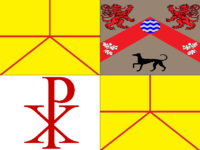Austenasian Monarchy
This article or section contains out-of-date information or information about an entity that is currently undergoing major changes. |
This article or section marked as work-in-progress has not been edited in over seven days, but further work is required. Please notify the user who first added this template. |
| Emperor of Austenasia | |
|---|---|
Imperial | |
 | |
| Incumbent | |
 | |
| HIM Emperor Aggelos I since 29 September 2024 | |
| Details | |
| Style | His Imperial Majesty |
| Heir apparent | HIH Crown Prince Shiro |
| First monarch | Terry I |
| Formation | 20 September 2008 |
| Residence | Imperial Residence |
The monarchy of Austenasia, ceremonially referred to as the Imperial Majesty, is the political institution comprising a Monarch of Austenasia and the Austenasian Imperial Family. The Monarch - males titled as Emperor and females as Empress - is head of state of Austenasia, by virtue of which they hold the extensive executive, legislative, judicial and military powers of the Throne. The fifth and current Monarch is HIM Emperor Aggelos I, who has held the Throne since September 2024.
Powers and duties
According to Austenasian law, the Monarch has sole prerogative over the following:
- The power to issue Imperial Decrees and Imperial Edicts.
- The power to approve Candidates for Prime Minister.
- The power to veto Acts of Parliament by not giving Imperial Consent.
- The power to appoint Representatives to the Cabinet (on the advice of the Prime Minister).
- The power to enter people into the four highest-ranking of the five Austenasian Orders of Chivalry.
- The power to appoint Landed Nobles to newly founded Towns, Provinces, Duchies and Regions.
- The power to grant peerages and the titles of Caesar and Augusta.
- The power to serve as Judge of the Imperial Court, to appoint juries, and to appoint the judges of High Courts.
- The power to govern Crown Dependencies, either directly (as in the case of Rushymia) or through the appointment of Governing Commissioners.
- The right to hold the secondary title of “Imperator/Imperatrix Caesar/Caesarina Forename Augustus/Augusta”.
- The right to have a sacrosanct and inviolable person.
- The position of commander-in-chief of the Austenasian Armed Forces.
Since the Second Amendment to the Constitution in January 2018, the Monarch has been required to "be a baptised Christian who professes belief in the Holy Trinity", with non-Christians being ineligible to accept or ascend to the Throne. Since the establishment of Christianity as the state religion of the Empire under Jonathan I in June 2017, the Monarch has held the title "Defender of the Faith", with the role of helping to defend Christianity from doctrinal attack and to promote education about the faith.
The Monarch has many more minor powers and duties, such as the right to nominate a Senator, and the power to announce the official start of each season in the Austenasian calendar.
History
Early monarchy
The monarchy of Austenasia was established on 20 September 2008 with the sending of the Declaration of Independence. Terry I was proclaimed Emperor, and the 2008 Constitution affirmed his role as Head of State. The 2008 Constitution was very brief and enabled subsequent Acts of Parliaments to clarify and further define the position of the monarchy within the Empire.
By convention, Terry I did not take a proactive role in government. His only real involvement in politics was granting Imperial Consent to pass Acts of Parliament into law; although during the first few months of the Empire’s existence proper Parliament meetings were held between the Monarch and Prime Minister to discuss new laws, by the time that South Kilttown joined the Empire in April 2009 the Monarch would automatically give Imperial Consent to an Act as long as it had been passed by Parliament, virtually regardless of whether or not he agreed with it. During the reign of Terry I, the Monarch was seen very much as a ceremonial figurehead, in a manner similar to the monarchs of the United Kingdom; this was emphasised in his coronation, when he was crowned with the Imperial Diadem by the Founder after making promises to rule wisely, uphold the law,
and defend Austenasia.
In October 2009, Parliament demonstrated its position of supremacy within the Empire by changing the line of succession to the Throne. It had done this several times previously to make the succession laws more similar to those of the British monarchy, but this time it placed somebody unrelated to the emperor through blood or marriage into the line of succession when the then Duke of Highland was made second in line to the Throne as a ceremonial honour, as it was not expected that Terry I would abdicate. When Emperor Terry suddenly did so in February 2010, the Duke ascended to the Throne after the Crown Prince refused to become Monarch, and became Emperor Esmond III.
Austenasian Civil War
Princess Caroline, who had been second in line to the Throne before Esmond was put in that position, protested against this, and claimed the Throne in her own right. When this claim was supported by military leader Lord General William, the Austenasian Civil War broke out, which at its heart was an ideological conflict between proponents of a monarchy which should be absolutely hereditary (the Carolinians) against proponents of a monarchy which should hold the approval of Parliament as the elected representatives of the population (the “Esmondians”, supported by the legitimate government).

The Austenasian Civil War can be considered a turning point in how the Austenasian monarchy was viewed. Firstly, it was ended not by military victory but by a referendum, supporting the theory that ultimate political power is held by the people but not necessarily putting Parliament above the Monarch. Secondly, Esmond III had always been more proactive than Terry I had been, and with the legitimate government at war on his behalf he inevitably became more than a figurehead. Helped along by the theory of Imperium which came into being around this time, the Monarch became seen as not merely the ceremonial head of Austenasia, but the leader and to some extent the personification of the Empire.
Growth of influence
Although no calls for an absolute monarchy came from outside the military, public sentiment was such that Parliament passed several laws between the end of the war in May and the start of the War of the Orlian Reunification in December which significantly increased the powers of the Monarch, at some points at their own expense. Act 124 (Imperial Powers), passed at the start of July, removed Parliament’s power to call a Vote of No Confidence to establish a Regency, gave the Monarch immunity from prosecution, and bestowed upon him the power to grant the titles of Caesar and Augusta (highly symbolic of the emphasis now placed on the imperial nature of the Monarch’s title). Act 127 (Regnal Names and Imperial Edicts), passed in September, gave the Monarch the right to issue Imperial Edicts; although limited in effect to Crown lands and unable to overrule Acts of Parliament, this was the first time that the Monarch could legislate independently of Parliament.
Another development during this period of time, also caused in some respects by the civil war, was the immense influence which the Austenasian monarch gained over the other Carshalton Nations. The Midget Nation-in-Exile informally accepted the Monarch as their overlord after declaring war on his behalf against the Carolinians, and Esmond III was instrumental in the founding of the Caesarship of Orly (the population of which was mostly comprised of Esmondian volunteer soldiers): since he gave its founder his title of Caesar, Orly’s successor states of Copan and the Grove considered their sovereignty to have derived from the Austenasian Throne and therefore acknowledged Esmond III as suzerain (Copan's king rejected Esmond’s suzerainty on). Esmond III also merged the nominal throne of Rushymia with that of Austenasia after gaining the title King of Rushymia in October.

The suzerainty of the Austenasian Monarch over the local nations was brought to an abrupt end by the outbreak of the War of the Orlian Reunification - at the end of the war, the Monarch of Austenasia would hold sovereignty, not just suzerainty, over every one of the local nations. King Declan of Copan became Regent of the Kingdom of the Grove on 8 December 2010, and united the two nations into the Tsardom of Orly. Esmond III had already maintained a friendly rivalry with Declan I after Copan was removed from his sphere of influence, but with the Grove now gone as well he declared a symbolic state of war between Orly and his titular nation of Rushymia. The Midget Nation considered their alliance with Orly to override their overlord-suzerain relationship with Esmond III, and so joined the war on Orly’s side, even making Declan I their new Midget Master. Austenasia then also declared a state of war so that it could mobilise its army in preparation for an anticipated Midget attack. Despite this, the Austenasian capital of Wrythe surrendered to a Midget attack force, and peace was declared. As part of the peace settlement, Declan I was made joint monarch of Austenasia and of Rushymia - he was now sole or joint monarch of every one of the Carshalton Nations.
In April the independent Midget Nation was abolished; the militaristic population was made a unit of the Austenasian Army, and the throne of the Midget Master was merged into the Austenasian Throne. Esmond III was removed from the powers of the Throne in late March by Parliament, and removed from the title of Monarch completely in September 2011 with the enactment of a new constitution, leaving Declan I as sole Monarch of Austenasia.
This led to a situation whereby Declan I ruled as Emperor of Austenasia, the Throne by virtue of which he was also Fifth Midget Master and King of Rushymia. He was also King of Orly, but this was merely in personal union with the Austenasian Throne, Orly being in political union with the Emperor's native country of Wilcsland as the United Kingdom of New Wessex.
Jonathan I
On 20 January 2013, Declan I abdicated for personal reasons from the Austenasian Throne, which passed to Crown Prince Jonathan, who after being Heir to the three previous Monarchs finally ascended the Throne as HIM Emperor Jonathan I later that day. Jonathan I also became the new King of Rushymia and Midget Master (these two titles were merged together on 1 January 2020), but Declan I remained King of Orly until the Liberation of Orly on 24 June 2013, upon which Austenasian suzerainty was reasserted over the entirety of the Carshalton Nations once more.
On 21 June 2017, the State Religion Act 2017 was passed by Parliament. This established Christianity as the state religion of the Empire, and gave the Monarch the role of "defending Christianity from doctrinal attacks and promoting the education of the Christian faith". The reign of Jonathan I had already seen an increase in the use of Christian elements and symbolism by the Throne, with his coronation oaths being made over a Bible and his imperial style being changed to include "By the Grace of Christ our God". In January the following year, a referendum was held which resulted in amendments being made to the Austenasian Constitution of 2011, one of which was the requirement that the Monarch must be a professing Trinitarian Christian in order both to accept and to retain the Throne. Another amendment allowed the Monarch to temporarily override the Constitution in the case of an absolute emergency; this was done by Jonathan I between 25 May and 4 June 2020 in response to deep political division within the government.
Recent history
On 30 April 2024, Jonathan I announced the implementation of a Regency, choosing to withdraw from frontline politics and the leadership of the nation. In response to widespread pressure he did not abdicate, but consented to remain as nominal Monarch while ceding the powers and duties of the Throne to the now Prince Regent Aggelos.
List of Monarchs
| Image | Name | Born | Became Monarch | Ceased to be Monarch | Succession | House | Personal emblem |
|---|---|---|---|---|---|---|---|
 |
Terry I | 16 May 1961 | 20 September 2008 | 16 February 2010 | Throne established. | Austen |  |
 |
Esmond III | 9 June 1995 | 16 February 2010 | 20 September 2011 | Appointed Heir by Parliament. | McLaughlin |  |
 |
Declan I | 20 May 1994 | 19 December 2010 | 20 January 2013 | Declared joint Emperor by Parliament. | Mac Donnchadha-Houghton |  |
 |
Jonathan I | 13 October 1994 | 20 January 2013 | 29 September 2024 | Son of Terry I. | Austen |  |
 |
Aggelos I | 1 September 1981 | 29 September 2024 | Incumbent | Appointed Heir by the Senate. | Vatazides |  |

Customs
Imperium
Since the reign of Esmond III, the Emperor of Austenasia has often been seen by Austenasians and other residents of the Carshalton Nations as the legitimate successor to the Western and Holy Roman Emperors. During the Austenasian Civil War, an operation known as Project Imperium was started, aiming to legitimise the claim of Esmond III to the title and rank of Emperor. Although this was kept secret from the general population, the Emperor himself was aware of it and began to promote his own identity as an imperial monarch in the medieval European tradition.
This led to a new political theory being adopted by the Austenasian government, based mainly on the Tetrarchy of the Roman Empire and the political theories of the Byzantine and Holy Roman Empires, sometimes referred to as Imperium. Briefly put, this is that the title of Emperor is the highest in diplomatic precedence, and that a person can only legitimately hold said title by either being the lawful successor to a previous emperor, or being recognised as such by another holder of that title while claiming the title of emperor and ruling an empire.
In May 2011, Dr. Sebastian Linden advanced a claim to the throne of the German Empire, which as a relative of Wilhelm II he was entitled to do so. As the closest living relative actively claiming the German throne, he became Regent under Hohenzollern House Law, attaining imperial rank and in effect re-founding the German Empire, as he had part of Cologne under his control (which he ceded to the Nemkhav Federation later that year, thereby losing absolute control over it). While German Emperor, Sebastian I recognised Esmond III and Declan I as holding the title of Emperor and the rank of Augustus, which legitimised Austenasia as the Western Empire in the view of the Carshalton Nations.
On 24 March 2012, the Seventh Imperial Decree of HIM Emperor Declan I was issued. This Decree codified as an official stance and policy of the Austenasian Government the view that the Austenasian Monarch was through translatio imperii the legitimate successor in dignity of the Western Roman Emperors, and claiming diplomatic precedence over all other rulers of the western world.
On 23 February 2013, Emperor Jonathan I recognised Taeglan I Nihilus of the Reylan Imperial Triumvirate as also holding the imperial rank, by the Treaty of Wrythe. Under this treaty, both emperors agreed that any further recognitions would only be valid of both of them gave their consent, thereby avoiding any possible future situations where a claimant to imperial rank might claim recognition based on being addressed as "emperor" by only one of the two monarchs.
Coronation
Although a coronation is not needed for the Monarch to either ascend to the Throne or to start ruling, three out of Austenasia's four Monarchs have to date held a coronation as a ceremonial celebration of their reign.
The first Emperor, Terry I, was happy to be a constitutionally-bound figurehead, and was seen more as a guarantor of national unity than as a political leader, similar to the monarchs of the United Kingdom. This was reflected in his coronation, where he was crowned with the Imperial Diadem (while holding the other Imperial Regalia of Austenasia) by the Founder after making a promise to rule fairly and wisely, to defend Austenasia, and to enforce and abide by its laws.
In contrast, Esmond III (Terry's successor) was a much more proactive leader, seen by the military and local supporters as the heir to the Roman Emperors, as Austenasia's supreme (although his powers were greatly limited by law and he was far from an absolute monarch) leader and as the personification of the Empire itself. This was reflected in his coronation, in which he took the Diadem from the Founder's hands and crowned himself, and made no promise like Terry I.
The Austenasian Constitution of 2011 contains the minimum requirements for coronations, but allows leeway in optional extra ceremony. Declan I is the only Monarch to date not to have set foot in the Empire, and so did not have a coronation. The coronation of his successor, Jonathan I, took place on 23 February 2013. That of Jonathan I was very similar to that of his father, although it was more elaborate and included some religious elements (e.g. giving the coronation oath over a Bible) to reflect the faith of the Monarch. Jonathan I crowned himself, although it was made clear that this was in his capacity as Founder and that he was not doing so in the manner in which Esmond III had.
Regnal numbering
The counting of the numbers of the Austenasian Monarchs include all previous rulers of the land which now comprises Austenasia. This includes the Kings and Queens of England, Scotland, Great Britain and the United Kingdom, as well as even further back to the Roman Empire.
As some areas of Austenasia (e.g. Glencrannog), being in the north of Britain, have historically had different rulers from those in the south (e.g. Greater Wrythe), Austenasian Monarchs take the next number from either sequence, whichever is higher.
Line of Succession
Officially, the Throne is intended to be inherited through male-preference (cognatic) primogeniture, as was the British throne at the time of Austenasia's foundation in 2008. However, in practice, succession to the Throne is not bound by hereditary rights, as demonstrated by the ascension of both Esmond III and Declan I; Parliament is constitutionally empowered to make any necessary changes to the Line of Succession, a power which was delegated to the Monarch and Senate on 11 July 2020.
After the abdication of Emperor Terry I, it was decided that the Line of Succession for the succeeding Monarch, Emperor Esmond III, would be the same as that of Emperor Terry, and that all in it would keep their titles, in order to ensure stability in the monarchy and so that the Throne would ultimately return to the House of Austen. The same was applied upon the accession of Emperor Declan I, and reaffirmed in the 2011 Constitution. Upon the abdication of Declan I, the Throne therefore passed to Jonathan I as son of Terry I, rather than to Prince Ciaran as brother of Declan.
In 2018, two laws were passed which enacted various restrictions regarding those eligible for the Throne. The Second Constitutional Amendment made it a constitutional requirement for members of the Line of Succession to be baptized Trinitarian Christians to be considered eligible for the Throne; members of the Line of Succession remain official members of such regardless of faith, but would be unable to ascend the Throne should it pass to them were they not to fulfil said requirement. Furthermore, the Succession to the Throne Act 2018 prevented those born to members of the Line of Succession not in a non-morganatic marriage from joining it, unless the marriage was approved by the Monarch.
On 1 January 2024, several relatives of the Emperor were removed from the Line of Succession by the Senate on the basis that they would be difficult to contact with short notice and almost certain to refuse the Throne, making their continued inclusion in the Line no more than an impediment to a swift change of ruler should the Heir refuse the Throne.
A far more radical implementation of this principle was put in place on 5 April 2024, when the Senate - by request of Jonathan I - voted to remove all his relatives from the Line of Succession and replace such with a list of five trusted statesmen he nominated for the purpose. This came after confirmation that none of his relatives in Line to the Throne - mostly aunts and cousins not even holding Austenasian nationality - would be interested in holding it in any more than name only should the opportunity arise. It was therefore decided to put in place a system based more on meritocracy than heredity, although any children born to Jonathan I will automatically join the Line (and, should they wish when older, likely be moved to its front).
The following is the current Line of Succession to the Throne of Austenasia. The ordinals (regnal numbers) each would most likely have should they ascend to the Throne are in brackets after the name (although which ordinal a Monarch takes upon ascension is, to a degree, their own choice). Upon the death or abdication of the Monarch, the Throne shall pass to the next eligible person in the Line of Succession:
Line of Sucession
as of 4 October 2024
His Imperial Majesty, Aggelos I
- HIH Crown Prince Shiro
- Lord William Wilson, Duke of Taysha
- Lord John Gordon, Viscount of Thetford
- HIM Emperor Adam I of Adammia
- Lord Michael Simpson, Count of Occibrazos
Style
In Acts of Parliament and legal usage, the Monarch is officially known as "HIM Emperor Jonathan I", with his standard full style being "His Imperial Majesty Imperator Caesar Jonathan Augustus, by the Grace of Christ our God faithful Austenasian Emperor and Autocrat of the Romans".
In some occasions, the ceremonial full style of the Monarch may be used, which is presently as follows:
His Imperial Majesty Jonathan the First, by the Grace of Christ our God faithful Austenasian Emperor and Autocrat of the Romans, Great King in Carshalton, Pharaoh and King of Persia, Lord of the Two Lands, King of Rushymia, Founder of Austenasia, Katechon and Defender of the Faith, Sovereign of the Glorious Order of St. John, Sovereign of the Order of Saint Constantine, Sovereign of the Order of the Bullmastiff, Sovereign of the Austenasian Order, Imperator of the Austenasian Armed Forces, Crown Steward of Imperial Wrythe, Protector of Orly and Wildflower Meadows, 2nd Archduke of Britannia, 1st Archduke of Northern Austenasia, 1st Count of Greater Wrythe, Sheriff of Glencrannog and Commius Flats, Duke of Sweetpea Valley, Prince of Arenberg-Salm, Kouropalates of Imvrassia, Duke of Carshalton, Duke of Argos, Marquis of Pemulwuy Common, Marquess of Hereford, Count at the Erft, Count of Groemant, Baron of Ongal, Baronet of West-Xtabay, Laird of Glencrannog, and Knight Protector of the Crown Princess.
Or, in Latin:
Eius Imperialis Maiestatis Imperator Caesar Jonathan Augustus, Christi nostri Dei Gratia pius Austenasiae Imperator et Moderator Romanorum, Rex Magnum in Carscalton, Pharao et Rex Persiae, Dominus Duarum Terrarum, Rex Ruscimiae, Fundator Austenasiae, Katechon et Fidei Defensor, Dominator Gloriosus Ordinem Sanctus Ioannis, Dominator Ordinem Sanctus Constantinus, Dominator Ordinem Bovisdougeis, Dominator Austenasiae Ordinem, Imperator Copiae Militarorum Austenasiae, Coronam Dispensatorem de Imperialis Virithiensis, Defensor Orliae et Flos Pratis, Secundus Archidux Britanniae, Primus Archidux Borealis Austenasiae, Primus Comes de Magnus Virithiensis, Vicecomiti Glencrannogae et Commius Plana, Dux Vallis Lathyri, Princeps Arenbergae et Salmae, Curopalate Imvrassiae, Dux Carscaltonae, Dux Argosae, Marchio Pemulvuy Commonae, Marchio Herefordiae, Comem ad Erftum, Comes Groemantae, Baro Ongalae, Baroninus Xtabaii Occidentalis, Dominus Glencrannogae, et Eques Defensus Principissa Coronae.
It should be noted that the full style of the Monarch is nearly never used, and prior to 14 October 2019 used to be even longer, with foreign knighthoods included.
Arms
The Imperial Standard of Austenasia is the flag used by the Monarch in their capacity as Emperor/Empress of Austenasia. It is only permitted to be flown from buildings in which the Monarch is and displayed on vehicles used by the Monarch during the times that they are used by them for official duties.
|
The Imperial Standard depicts the Coat of Arms of the Empire of Austenasia - that is, four quadrants, depicting in the first and fourth quarters the Austenasian Star, in the second quarter the arms of the British town of Carshalton from which Wrythe declared independence as the Empire of Austenasia, and in the third quarter the Chi-Ro (for historical purposes, signifying that what is now Austenasia was formerly part of the Western Roman Empire, the Chi-Ro being part of the imperial insignia of the late Empire, and for cultural purposes, referring to the large amount of Christians in Austenasia).
